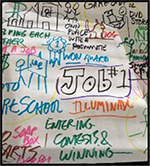-
About Us -
Topics -
Resources -
Events -
TTA - Contact Us
- Search

Person Centered Planning: A Backwards Planning Model
Martin was an 18-year-old student with autism spectrum disorder, who qualified for vocational rehabilitation, behavior support, and in-home services from agencies outside the school. Although Martin was lucky to receive outside supports, his teacher struggled to coordinate and develop a clear transition plan across agencies. Agency representatives attended planning meetings; however, at the end of the meetings the teacher felt there was no clear plan of action. After a year of struggling, Martin’s teacher decided to research effective transition planning models that promote coordination among schools and multiple agencies. In her search, she found the Backwards Planning process. This process focuses on identifying a student’s future aspirations and then planning backwards to identify steps needed to reach each goal. The process is used to inform instructional decisions and to determine what experiences are needed during high school and into the first few years of adulthood.
To begin the Backwards Planning process the teacher invited Martin’s Individualized Education Program (IEP) team to attend an informal meeting to discuss transition planning. The team consisted of Martin, his guardian, special education teacher, other school personnel, vocational rehabilitation counselor, behavior specialist, and home service provider. Prior to the meeting the team members were provided with information on the Backwards Planning Model. Additionally, Martin was given a questionnaire to fill out that asked him about his long-term goals in areas such as employment, living options, leisure activities, and any other goals he had after high school. Martin was then asked to bring the questionnaire with him to the meeting.
During the meeting, Martin shared his goals, and as he shared, each goal was represented on a large piece of paper. Martin’s main goal was to get a job as a cashier at a local game store. The team brainstormed several important skills he would need to achieve this goal. These skills included: (a) communicating effectively with co-workers, supervisors, and customers; (b) self-monitoring and regulating behavior; (c) developing financial literacy; (d) operating a credit card machine and cash register; (e) gaining knowledge of merchandise; and (f) improving hygiene. The team also identified several experiences that could help him learn or refine these skills. These experiences included: (a) job sampling, (b) job shadowing, (c) work-based learning opportunities, (d) internships, and (e) supported employment.
Next, the team had to decide which agencies and school personnel would be responsible for providing the instruction, supports, and experiences. In the past, accountability was an issue. Agencies would commit to providing resources and services, but then failed to follow through. To prevent this problem from occurring, the teacher wrote down the specific resources, supports, and/or instruction each team member agreed to provide and gave a copy of the plan to each team member at the end of the meeting.
Table 1 provides an overview of the responsibilities each team member agreed to fulfill. To ensure each member would be held accountable, at the end of the meeting, the team collectively chose a date for when all services and supports would be in place and agreed to meet on that date to discuss progress and any other issues or concerns.
Table 1
Team Member Responsibilities
| Team Member | Responsibilities |
| Martin |
|
| Vocational Rehabilitation Counselor |
|
| Behavior Specialist |
|
| Home Service Provider |
|
| Home Service Provider and Guardian |
|
| Special Education Teacher |
|
Today Martin is 25 years old and has been successfully employed at a local Game Stop for 4 years. Although Martin’s teacher is no longer a part of the team since he graduated from school, his service providers continue to meet and coordinate services
regularly. Not only did the Backwards Planning Model help Martin’s team to develop a clear plan for preparing him for adulthood, but it also opened the lines of communication across agencies and promoted accountability.
